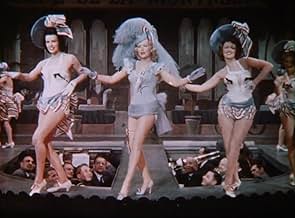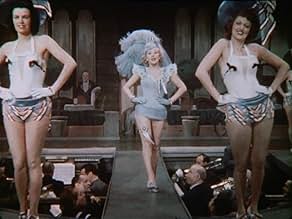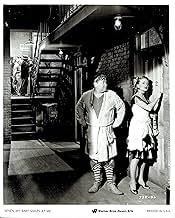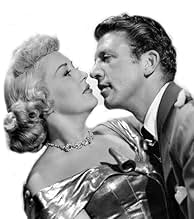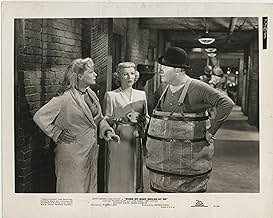Adicionar um enredo no seu idiomaVaudeville performers, Dailey and Grable, have marital difficulties when he hits the "Big Time", which are compounded by his drinking problem.Vaudeville performers, Dailey and Grable, have marital difficulties when he hits the "Big Time", which are compounded by his drinking problem.Vaudeville performers, Dailey and Grable, have marital difficulties when he hits the "Big Time", which are compounded by his drinking problem.
- Indicado a 2 Oscars
- 3 indicações no total
Louise Allen
- Dancer
- (não creditado)
Maxine Ardell
- Dancer
- (não creditado)
Dorothy Babb
- Specialty Dancer
- (não creditado)
Betty Jane Barton
- Dancer
- (não creditado)
Pati Behrs
- Woman in Box
- (não creditado)
Sam Bernard
- Process Server
- (não creditado)
Lela Bliss
- Woman
- (não creditado)
Harry Carter
- Man in Box
- (não creditado)
Edward Clark
- Box-Office Clerk
- (não creditado)
Joanna Dale
- Chorus Girl
- (não creditado)
Grace Davies
- Dancert
- (não creditado)
Enredo
Você sabia?
- CuriosidadesDan Dailey's Best Actor Oscar nomination marked a career high-point, though his portrayal of 'Skid' Johnson never stood a chance opposite Laurence Olivier's loftier central performance in the same year's Hamlet (1948). This illustrates the sometimes ludicrous range of nominations in the acting categories during Hollywood's golden era, the result of a far wider spectrum of genres represented. A similar disparity had emerged three years earlier when Gene Kelly's lighthearted performance in the musical Anchors Aweigh (1945) was improbably pitted against Ray Milland's histrionic performance as a desperate alcoholic in The Lost Weekend (1945).
- Citações
'Skid' Johnson: Here's to you babe. One man's loss is another man's gain.
- ConexõesFeatured in Biografias: Betty Grable: Behind the Pin-up (1995)
Avaliação em destaque
In general, this movie is just a fair musical and drama with a touch of comedy. But, two things raise it a couple of notches and give it historical value. The first is its excellent picture of vaudeville. The second is its portrayal of alcoholism and early social views about it.
"When My Baby Smiles at Me" is one of the best movie exposés of vaudeville. It shows what it was like for performers who made a living traveling in such stage shows of the late 19th and early 20th centuries in the U.S. and Canada. It shows the various types of entertainment - comedy, song and dance, burlesque, small dramatic acts and skits, that made up vaudeville. Some also had acrobats, magic and animal acts.
By the mid-20th century, burlesque had faded from the scene and TV combined with the movies to end the reign of vaudeville. But a form of revue shows continued to be popular on TV where they became known as variety shows. The Ed Sullivan Show reigned as king of this type of entertainment from June 1948 to June 1971. Only then, the talent competition was much greater and the quality of entertainers was always high. Song and dance and comedy remained the chief forms of entertainment, but acrobatics had a new venue for such talent formerly seen only in circuses. And, trained animals and special talents and skills of all kinds were regularly featured.
In this movie, the cast does a fine job in showing the backstage angst about late performers, and the hustle and bustle of actors as they quickly change makeup and costumes between sets to hurry onto stage for their next act. Betty Grable and Dan Dailey aren't a match for Ginger Rogers and Fred Astaire. But they are good in this film, and show us what in that time would have been considered very good or top entertainment on the vaudeville circuit. Likewise with Jack Oakie and June Havoc.
Then, there's Dailey's performance as Skid Johnson, who has a drinking problem. And Grable's role as Bonny Kane, his wife, who doesn't know what to do and can't make him stop drinking. The film isn't long enough to have included more of the picture of the entertainer in his slide from heavy drinking to alcoholism. That would have included more than his being habitually late for show starts. He would have begun to forget a line or two, perhaps slur a line, stagger noticeably, forget things the next day.
But, in the throes of his addiction, Johnson is the picture of the helpless and forlorn alcoholic. His portrayal is very real. Many viewers may miss some of the telltale signs of alcoholism shown here. Those who have personal experience with it will note some of the signs beyond the amount and frequency of Johnson's drinking. Particularly poignant is the scene in which Johnson says that he went to pieces when Bonny left him. That's a common trait of alcoholic denial, excuse and blame. He puts it elsewhere - on his wife. Those of us with experience in 12-step programs know this as the "poor me" attitude. It oozes self-pity and smothers any need for one to come to grips with his or her own culpability.
But, there's more to the "treatment" of alcoholism than that in this movie. The film takes place in the 1920s. That was during prohibition when speakeasies flourished across America. It was also before the birth of 12-Step programs to treat addictions. Alcoholics Anonymous got its start in 1935, and spread widely only after World War II.
The film shows Bonny Kane unable to do anything to stop Johnson's drinking or tackle his alcoholism. She falls into a trap and role that continues to enable the alcoholic to be what he is. It's interesting that the movie doesn't ever use the words alcoholic or alcoholism. Even when Johnson is in a hospital ward at New York's Bellevue Hospital, there's no mention of alcoholism.
Dailey's performance overall was excellent of an alcoholic personality. He promises to quit and has his last drink, but doesn't follow through. He hides empty bottles. He doesn't hesitate to offer someone else a drink or have one when someone else suggests it. He has no remorse about his boozing or its effect on his wife. But he does love her. That's the insidiousness of alcoholism. In the hospital and later, he genuinely looks to be suffering from the disease. The only obviously unbelievable scene is at the end when Skid Johnson has all the energy and vitality to do the last song and dance number with Bonny Kane.
Dailey received his only Oscar nomination for his role in this film, and it was well deserved. But for Laurence Olivier's "Hamlet" in 1948, Dan Dailey may well have won the best actor Oscar that year.
"When My Baby Smiles at Me" is one of the best movie exposés of vaudeville. It shows what it was like for performers who made a living traveling in such stage shows of the late 19th and early 20th centuries in the U.S. and Canada. It shows the various types of entertainment - comedy, song and dance, burlesque, small dramatic acts and skits, that made up vaudeville. Some also had acrobats, magic and animal acts.
By the mid-20th century, burlesque had faded from the scene and TV combined with the movies to end the reign of vaudeville. But a form of revue shows continued to be popular on TV where they became known as variety shows. The Ed Sullivan Show reigned as king of this type of entertainment from June 1948 to June 1971. Only then, the talent competition was much greater and the quality of entertainers was always high. Song and dance and comedy remained the chief forms of entertainment, but acrobatics had a new venue for such talent formerly seen only in circuses. And, trained animals and special talents and skills of all kinds were regularly featured.
In this movie, the cast does a fine job in showing the backstage angst about late performers, and the hustle and bustle of actors as they quickly change makeup and costumes between sets to hurry onto stage for their next act. Betty Grable and Dan Dailey aren't a match for Ginger Rogers and Fred Astaire. But they are good in this film, and show us what in that time would have been considered very good or top entertainment on the vaudeville circuit. Likewise with Jack Oakie and June Havoc.
Then, there's Dailey's performance as Skid Johnson, who has a drinking problem. And Grable's role as Bonny Kane, his wife, who doesn't know what to do and can't make him stop drinking. The film isn't long enough to have included more of the picture of the entertainer in his slide from heavy drinking to alcoholism. That would have included more than his being habitually late for show starts. He would have begun to forget a line or two, perhaps slur a line, stagger noticeably, forget things the next day.
But, in the throes of his addiction, Johnson is the picture of the helpless and forlorn alcoholic. His portrayal is very real. Many viewers may miss some of the telltale signs of alcoholism shown here. Those who have personal experience with it will note some of the signs beyond the amount and frequency of Johnson's drinking. Particularly poignant is the scene in which Johnson says that he went to pieces when Bonny left him. That's a common trait of alcoholic denial, excuse and blame. He puts it elsewhere - on his wife. Those of us with experience in 12-step programs know this as the "poor me" attitude. It oozes self-pity and smothers any need for one to come to grips with his or her own culpability.
But, there's more to the "treatment" of alcoholism than that in this movie. The film takes place in the 1920s. That was during prohibition when speakeasies flourished across America. It was also before the birth of 12-Step programs to treat addictions. Alcoholics Anonymous got its start in 1935, and spread widely only after World War II.
The film shows Bonny Kane unable to do anything to stop Johnson's drinking or tackle his alcoholism. She falls into a trap and role that continues to enable the alcoholic to be what he is. It's interesting that the movie doesn't ever use the words alcoholic or alcoholism. Even when Johnson is in a hospital ward at New York's Bellevue Hospital, there's no mention of alcoholism.
Dailey's performance overall was excellent of an alcoholic personality. He promises to quit and has his last drink, but doesn't follow through. He hides empty bottles. He doesn't hesitate to offer someone else a drink or have one when someone else suggests it. He has no remorse about his boozing or its effect on his wife. But he does love her. That's the insidiousness of alcoholism. In the hospital and later, he genuinely looks to be suffering from the disease. The only obviously unbelievable scene is at the end when Skid Johnson has all the energy and vitality to do the last song and dance number with Bonny Kane.
Dailey received his only Oscar nomination for his role in this film, and it was well deserved. But for Laurence Olivier's "Hamlet" in 1948, Dan Dailey may well have won the best actor Oscar that year.
- SimonJack
- 1 de jun. de 2018
- Link permanente
Principais escolhas
Faça login para avaliar e ver a lista de recomendações personalizadas
Detalhes
- Data de lançamento
- País de origem
- Idioma
- Também conhecido como
- Quando o Amor Sorri
- Locações de filme
- Empresa de produção
- Consulte mais créditos da empresa na IMDbPro
- Tempo de duração1 hora 38 minutos
- Proporção
- 1.37 : 1
Contribua para esta página
Sugerir uma alteração ou adicionar conteúdo ausente

Principal brecha
By what name was When My Baby Smiles at Me (1948) officially released in Canada in English?
Responda
